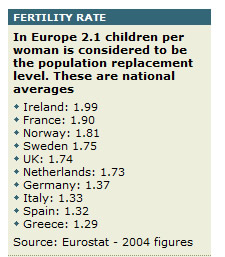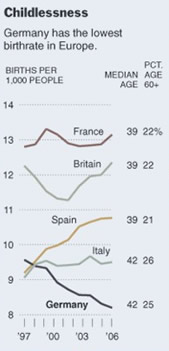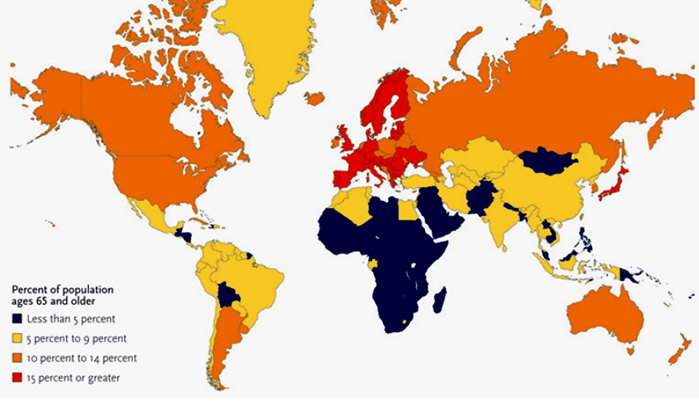
WE NEED MORE BABIES!The Continent's plummeting fertility rate is a time bomb, threatening economic growth and social welfare. But what can governments do about it? How states are trying to get people to have more kids. |
| When Ester Blandford was born, 18 months ago, the Swedish state did all it could to ease her way into the world — and encourage her parents to have even more kids. Her mother, Therese, 29, a children's librarian in the small southern town of Nyhamnsläge, took 15 months off work, most of it at 80% pay, to care for the baby, her first child. She now works part-time. Ester's dad, Christian, also 29, a physical therapist, stays home one day a week to help out. He too gets 80% pay from the state for the day spent with his daughter. |
|
If Ester is sick, her father or mother can stay at home for up to a total of 120 days a year to look after her — their lost wages are paid by the state. Therese and Christian would like four children and can look forward to increasing child allowances — from €105 per month for Ester to €190 for No. 4 — if they get that far. For Therese, it also helps to know her job will be waiting for her when she returns to the workforce. "I know I can come back to my job and get my old responsibilities back," she says. "I'm not discriminated against because I raise children." |
 |
All that costly government support has helped boost Sweden's fertility rate from a paltry 1.5 children per woman in 1999 to 1.75 in 2004 — but that's still not enough to keep the Swedish population from declining without immigration. And Sweden is a success story. In much of Europe, fertility rates have plummeted over the past few decades. Western European women were having an average of 2.4 children each in 1970. But as women pursued higher education, increased their role in the workforce and started having babies later, that figure has fallen to 1.5 last year. | In the newer member states of Central and Eastern Europe, the drop-off has been even deeper. That means that the population of the E.U. could drop from 482 million today to 454 million by 2050. In the same period, the E.U.'s working age population is projected to drop by 18% while the number of those aged 65 or more will soar by 60%. | |
|
|
| Hospital maternity wards already stand empty in parts of Latvia and Slovakia, and schools are closing in eastern Germany for lack of pupils. Germany, in fact, is experiencing such a birth dearth that its population could crash from 82 million to 24 million by the end of the century. |  |
If the trend continues, former Dutch Prime Minister Wim Kok suggested in a report to the European Council earlier this month, within a generation spiraling pension and health costs will bust European state budgets — and cripple the Continent's economic growth rate. |
| Like Sweden and its Scandinavian neighbors, Britain, Ireland, France and the Netherlands are faring relatively well, with fertility rates above 1.7. Yet nowhere in the European Union does fertility approach 2.1, the level needed to keep the population stable. |  |
"A people that doesn't have children, that grows old, is a people without a future," says Tiziano Treu, a former Italian Minister of Labor and Welfare who recently co-authored a bill aimed at boosting Italy's rock-bottom birth rate of 1.29. |
| The problem has been looming for decades, and governments have responded with schemes to reform pension programs, raise retirement ages, increase labor participation rates and encourage the immigration of skilled workers. Low birth rates "will have a major impact on Europe's economic future," says Jonathan Grant, director of independent thinktank RAND Europe's Cambridge office and principal author of a study of European fertility released last year. | Ron Lesthaeghe, a demographer at the Free University of Brussels (V.U.B, says," Immigration has so far staved off population shrinkage in countries like Germany, where death rates already exceed birth rates, but even at numbers far beyond current levels it will have scant influence on the long-term balance among generations. After all, immigrants get old, too (and their birth rates decline within a generation of moving to Europe). |  |
||
| Lesthaeghe warns that there's no quick fix. "We need to get back to two children per family," he says. "But even if we were able to do that, our population would continue to decline for decades because we've got an old population, and that means a higher death rate." |
| Last year's RAND study found that countries that invest in policies to make it easier to have and raise children tend to have higher fertility rates than those that don't. The parade example is France, which after Ireland has the highest rate in Europe, 1.90. "France has always had a strong family policy," says demographer Marie-Thérèse Letablier of the Center for Employment Studies near Paris. In its present form, that means women bearing their first child get a paid and job-protected maternity leave of 16 weeks as well as a palette of allowances to help out with everything from education to housing to transportation; the benefits increase steeply for the third child. Partly as a result of policies like these, France had a net natural gain in population last year of 211,000, while the E.U. as a whole only had a net natural gain of 200,000, not including immigration. |  |
Low fertility rates in Italy and Spain, also 1.29, spring from high youth unemployment, the prevalence of short-term work contracts, a chronic shortage of affordable housing for young people — and a bias in the workplace against women who interrupt their careers to have kids. Barbara Cavuto, 35, a Rome manager at an employment services company who is eight months pregnant with her first child, says combining family and career still doesn't seem like a realistic possibility for Italian women. "Turning 35 is just about the limit beyond which it becomes more difficult to have and raise children," she says. "My company is not uncaring, but in Italy you're either seen as ambitious or not. And having a child is seen as a sign that you're not." |
| Amid all the bad news, there are positive signs. For one, European Commission studies suggest that throughout Europe, women say they would like to have more children than they do. One way to make that possible is to ensure that the goals of career and parenthood are compatible. That seems to have been accomplished in places like Sweden, where women's participation in the labor force is high and so is fertility. It's an expensive solution — critics might call it a parenthood bribe — since the government pays for maternity and paternity leave, health care and education benefits. And it's a level of social spending some say Europe can no longer afford. |  |
But the alternative — too few young people to take care of the old — may be even costlier. In Spain, Zapatero is hoping to push his country in the Scandinavian direction by urging companies to set up child-care facilities, subsidizing university fees and promoting long-term employment over short-term contracts. More generous policies like those of France and Scandinavia would require higher taxes, a trade-off many European governments aren't willing to make. |
| "What we need is a good cocktail," says Lesthaeghe, "more policies aimed at promoting flexibility between work and home — day-care centers, early schooling, flex time — but also a doubling of immigration rates and higher participation in the labor market for older people and women." But unless it becomes more palatable, affordable and even fashionable for families to consist of two or more children again, Europe risks becoming an Old World in the worst sense of the term. | |
 |